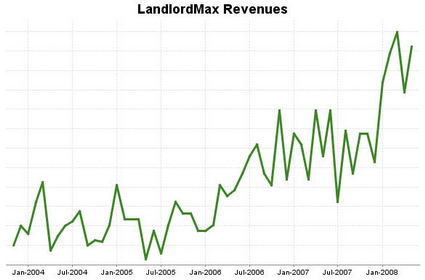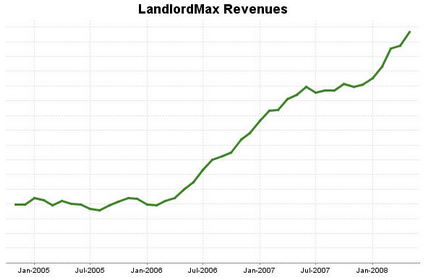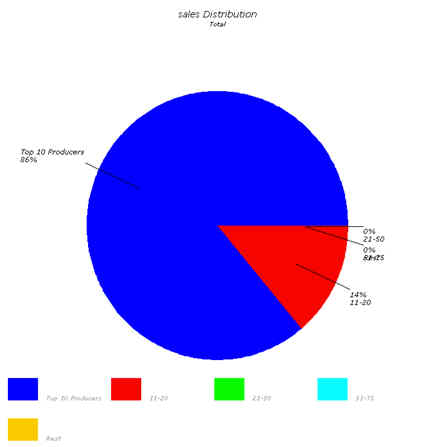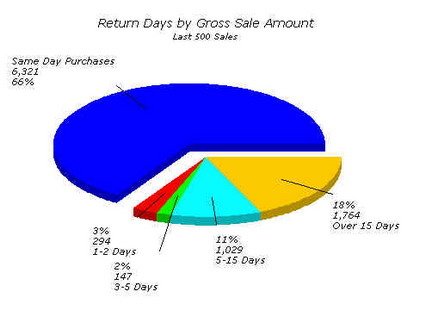The Value of Your Brand's Credibility
Intentionally or not, every brand ends up representing certain qualities. If you follow the 22 Immutable Laws of Marketing, you can only be known for one thing, and only thing, in people’s minds. Either you’re the easiest, the fastest, the cheapest, the most luxurious, or whatever, it’s one and only one thing. Although I believe this to be true in most cases, I don’t think it’s universal to all brands. For example I believe Apple is known for two things. Apple is of course known for its innovative products like the iPhone/iTouch. But more than that, Apple is also known “to just work”.
What do I mean by “to just work”? A common belief about Apple is that their stuff just works. And right out of the box! You don’t need to spend time fixing it. You don’t have to worry about viruses. You don’t have to worry about spyware. You don’t have to worry about your computer crashing. If you buy a peripheral for your Apple computer it works. It just WORKS!
Even Apple is capitalizing on this belief. We’re all familiar with the Apple commercials with the cool hip guy talking to the older, larger, and more corporate guy discussing Apple versus Windows. And of course there’s my favorite with the Windows guy repeating himself over and over about how he’s been error free for nearly a week.
The thing to note is not whether or not this is true, but rather that it’s perceived that way by the public. It’s a common belief. You can’t argue that fact. You can argue whether or not it’s true, but you can’t argue that it’s a common belief.
Many people are buying Apple’s just to avoid dealing with issues they face on their Windows systems. Of course the issues won’t disappear, well maybe for a bit, but with time as they neglect to upgrade their machines, connect them without firewall/routers, install all kinds of crapware, the issues will come back. But ignoring that fact, the common belief out there is that Apple computers just work, and that they’re immune to all these issues. And Apple hasn’t been shy to leverage this belief.
Unfortunately however all is not rosy. With their latest release of the iPhone/iTouch software, version 2.0 (and even the recent 2.0.1 upgrade), they’ve introduced a very buggy and unstable operating system. I personally own an iTouch and upgraded mine from version 1.0 to version 2.0. I can tell you that before the upgrade I maybe rebooted once or twice in total, which is great. On the same hardware, since upgrading to version 2.0 (and 2.0.1), I can’t remember a single day I haven’t had to reboot! Wow! It’s not the hardware, it’s the operating system.
I’m by far not the only one, lots and lots of people are complaining. It’s starting to be refered to as the “White Apple Logo Screen of Death.” There are issues of random reboots. Extremely long synch ups. Network connections being dropped. Battery lives being sucked incredibly fast. Very slow UI response times at random intervals (up to ten’s of seconds where the system is locked). Complete “bricking” of the machine where you need to reset it to factory defaults which takes the better part of a day! The system completely corrupting almost every time you select “Upgrade All” for your installed apps. You name it, it’s all happening. And that’s nothing compared to the outcry from the developers!
Which leads us back to our initial question, the title of this post: What’s the value of your brand’s credibility? In other words, for a brand that’s known to “just work”, what’s going to be effect of releasing a very unstable system riddled with bugs. It will greatly affect it’s credibility, and hence it will affect its revenues. The question is how much?
Luckily for Apple they’ve got a lot of brand power when it comes to just working. This release definitely didn’t just work. There are already people comparing Apple’s latest 2.0/2.0.1 iPhone/iTouch OS to a Microsoft OS release. I can’t imagine what will happen if they call version 2.1 a service pack?. But I’m getting off topic. The question is how much will it harm their credibility of just working?
In the tech community you can generally get away with one, maybe two if you’re very lucky, bad releases assuming you’ve previously been consistently good. But you better fix those bad versions very quickly. The longer it takes to release version 2.1, the bigger the hit on their credibility.
But worse yet, Apple’s “can do no wrong” credibility has definitely been hurt. “It just works” is no longer true. They pushed out a product way before it was ready for mainstream. The common theme in the online community is that version 2.0 was barely Beta worthy.
I believe they may just get away with it this time. But they’ve just played their only “Get out of Jail Free” card which means version 3.0 had better be good. Not only that, but the upcoming 2.1 update had also better offer a significant improvement in stability otherwise there will be a lot of backlash from the community. The belief that Apple’s products “just work” will no longer hold true. And that will affect them across the board. Not just for the iPhone/iTouch, but with all their products!!!
Remember many people are buying Apple computers because they’re perceived to just work. Again, whether or not this is true doesn’t matter, the perception and reputation is there in the minds of the average consumer. And if Apple loses this, then the perceived advantage Apple has over Windows will quickly erode. It will alter the OS war in a very significant way.
Branding is important. It lets people know what you or your company is all about. Branding is what differentiates you. It’s what builds loyalty. It’s what ultimately creates your evangelists. It’s defines you in the minds of other people. If you destroy the essence of who or what you are expect there to be dire consequences. Branding takes a lifetime to build and only seconds to destroy!
Permalink to this article Discussions (3)
50% Discount on How to Generate Traffic Ebook!
Ever since the ebook appeared on Bits du Jour, I’ve been considered reducing the price by 50%. I also have to admit I just haven’t had the appropriate time to allocate to marketing the book, what with Interview the Pros (the traditionally published book I have coming out soon) and the upcoming major release of LandlordMax.
In any case, I’ve just reduced the price of the ebook by 50% tonight. I’m going to give that a try, at least for now. I don’t know how long it will last, so if you’ve been on the fence nows a good time to take advantage of this offer. I definitely will never reduce the price lower than it is today. If anything else, once I have some time to really market it, the price will likely increase.
Considering how affordably priced I thought it was before, now it’s an even greater deal. It’s now less than the price of going to a movie with a popcorn and drink!!! You can’t beat that. Check it out now!
Permalink to this article Discussions (2)
What's the Real Value of a Guarantee/Warranty?
Not all guarantees and warranties are worth the same. For example here at LandlordMax we guarantee that we will give you a refund within 30 days of buying LandlordMax if your not completely satisfied (remember this is after trying it for free for 30 days before purchasing it). We’ve honored this guarantee every single time!
However not all companies create guarantees with the intentions of honoring them. And even those that do might not (especially if money starts to get tight). Let me start with an example of a useless guarantee (sometimes also called a warranty – we’ll assume for this post that they are the same although there are minor differences). A year ago I bought a dehumidifier for my house, a Honeywell. With the dehumidifier came a 5 year guarantee. If anything was to go wrong, they would immediately replace the unit. All I had to do was call the 800 number listed in very large and bold letters on the box, in the manual, and so on.
As you can guess, the dehumidifier broke before the guarantee was up. It actually broke within a year, less than 20% of it’s guaranteed lifespan. So I obviously called the big bold number listed everywhere that had influenced my purchasing decision. On a side note, I ended up buying two units, one for our house and one for my mom’s house. Both units stopped working within a year, so I suspect there are some production issues.
In any case, after calling the number I discovered that Honeywell itself doesn’t actually manage the guarantees, they’ve outsourced that to another company. Not a big deal, but if you’re going to outsource it’s important to make sure the company that you use to outsource does a good job and represents you well. Turns out that the company they outsourced for was no longer around. But they gave us another number to another to call so that we could take advantage of the guarantee.
Again I took the phone and made a call so that I could exercise the guarantee. And in this second case, the company is pretty much clueless. They don’t really know what to do, so they take my name and phone number and promise to call back within a few days with some answers. Of course being busy as I am I forgot to follow-up within a few days, and I ended up calling a few weeks later. Still the same response, we’ll call you in a few days. Nothing again. It’s as if no one’s there. And this wasn’t just me, my mother, with her faulty unit, also had an identical experience.
It’s almost as though they’re trying to ignore us hoping that the problem will go away. And it did, we both eventually gave up and got ourselves other different units. But rest assured it wasn’t from Honeywell, it was from another brand. I’ll never buy another Honeywell dehumidifier again. Even though my experience with their home thermostat has been very positive this experience has really soured me on their company. I now place absolutely no value in their guaranties and warranties. They just don’t honor them. Getting rid of their obligations through attrition is very deplorable!
But who’s going to go after them to enforce the guarantee. I need a replacement now, not much later. And I’m for sure not going to spend my time chasing down a few hundred dollars that will likely never come when I could make multiples of that working on my business. So they’ve just basically got the benefits (increase in sales conversions) from their guarantee without having to enforce it. Maybe it’s different with other departments within the company, but for this dehumidifier unit they definitely own up to their claim.
The moral of this story is be careful when you make a purchasing decision, especially if you put a lot of value on the guarantee or warranty. Don’t just assume it will be honored. Look at who you’re buying from and see if they have a history of owning up to their guarantee. Check their reputation. And only then put value into the warranty.
And one last thing, the longer the duration of the warranty, the less value you should put on it. For example, the odds of a lifetime warranty being honored after 20+ years of purchase are pretty low. They’re assuming you’ll have moved on, lost your receipts, there is no equivalent replacement unit, or maybe even that the company might not be there anymore. I personally won’t trust anything beyond a 5 year guarantee, and even than my trust is limited. For example you can be pretty confident that most car manufacturers will honor their warranties. But I wouldn’t put any weight in a $40 coffee maker 20 year guarantee. And is it even worth your time to follow through with a $40 guarantee after 15 years…
Permalink to this article Discussions (0)
How to Generate Traffic to Your Website – Andy Brice Review
Earlier this month Andy Brice of Successful Software wrote a review of my ebook How to Generate Traffic to Your Website. The following is a quick highlight of Andy’s review:
“On the whole I think it is a very good introduction to marketing websites. At 136 pages there is plenty of ‘meat’ and a good balance between depth and breadth of coverage. Steph illustrates many of the topics with his own real-world experience with landlordmax.com.”
You can read his full review here. Thanks Andy for taking the time to review the book.
For those of you who are just hearing about this ebook for the first time, you can read the first 21 pages free here. You can also find several more reviews here. And if you’d like you can purchase it right now.
Permalink to this article Discussions (0)
Top 16 Podcasts
Recently I purchased myself an iTouch, and I have to say it’s an amazing little device. My only complaint so far is that I purchased the 16Gb rather than the 32Gb (I always seem to be running out of room because of all the podcasts I load up on it). Actually, that’s not really true, I’m finding that iTunes on Windows is another of my complaints, it’s an extreme CPU hog. Just downloading files often brings the CPU usage to 100%. Who knows why…
In any case, here’s my current list of the best podcasts I was able to find:
Marketing
Software Development
- IT Conversations
- Software Engineering Radio
- StackOverFlow
- Java Posse
- IBM developerWorks
- UIE Brain Sparks
Technology and Science
General
Some of these podcasts are obviously better than others, but overall I’ve enjoyed almost every podcasts from every single one of these sources. If I had to pick my favorites, they would be Ted Talks (the speakers at Ted are just amazing – I can’t say enough about these video podcasts), Internet Marketing Insider, StackOverFlow, Software Engineering Radio, and Java Posse. I’d also like to include IT Conversations in this list but it’s still too new to me. And don’t get me wrong, the others are great, these just happen to be the best of the best.
And if I’ve missed your podcast, or if you know of other great podcasts, please don’t hesitate to comment below. I’m always on the lookout for great podcasts, especially video based podcasts (video casts).
Permalink to this article Discussions (0)
Status Update
Normally in the past I’ve posted updates about what we’re doing here at LandlordMax (as well as my other projects) every six months to a year. Well I’m now going to try to increase that frequency to every 2-3 months. I’m doing this because it forces me to look more frequently at our successes and failures in detail. I always do some checks each month, but by forcing myself to post about the more interesting metrics on a regular basis will force me to look deeper into these metrics. Hopefully finding some great nuggets of information along the way.
Firstly, the most exciting and good news is our traffic metrics at LandlordMax. Our traffic, as measured in by unique visitors, has increased by a whopping of 108% in the last 6 months!! That’s our biggest success as it is translating into more sales.
As well our revenue growth is continuing to be very positive, which is great to see. For those of you who are fairly new here, in early April I posted a graph of our sales revenues over the last few years. In that graph there was somewhat of a spike in 2008. I’m glad to report it wasn’t just a one-off spike for January and February, it’s a consistent growth in revenue. May is already looking like another very big month, possibly the biggest yet!
I decided to also push the data further and generate a moving average graph using a 12 month trailing period (which is why the first 12 months are missing from this graph). I have to admit I was surprised with the results, it’s much better than I expected! As you can see below, we’re definitely moving in the right direction. The real estate bust is not hampering our growth, so it’s not all bad news out there. It’s definitely not all doom and gloom for everyone as you can clearly see.
Some other interesting news, FollowSteph is still growing at a very good pace. In the last 6 months the traffic on this blog has grown by 46% which is great. Although I was hoping to more than double it every 6 months, I can’t complain with this growth rate. The good news is that the RSS feed subscription rate has grown much faster than that, it’s pretty doubled in the same amount of time.
As for the book Interview the Pros: What does it take to create a Successful Blog?, it’s still being edited by my publisher. These things take time, which I have to admit is excruiating for me. I like to have things moving, I’m not a big fan of waiting. But the good news is that the book already has it’s own official ISBN number assigned to it. And most of the book’s cover and back copy is ready to go. It’s going to be available in both as a soft and hard cover book. I’ll let you all know as soon as the editing phase is done, which hopefully will be sooner than later. As well I have to finish the website for the book pretty soon, so I can start to do some pre-marketing. I’ll let you all know when the website is available.
As for the ebook I wrote How to Generate Traffic to Your Website it’s done fairly well overall. I have to admit I was hoping for better results, but this topic seems to be saturated with lower quality ebooks. In other words a lot of people are suspicious of all books on this topic because of some bad experiences, so you really have to push hard to make the sale which isn’t really where I want to be (I don’t want to compete with the long spammy sales letters). However what’s been really interested is that ALL the reviews it’s gotten have been favorable! And each time a review came out there was definitely a spike in sales. But between reviews it’s pretty quiet. So I’m looking into what are my options for the future of this ebook…
Otherwise everything else is moving along very well. The biggest item is that we’re always working very hard on releasing the next major version of LandlordMax as soon as possible, which is coming together very nicely. Just extremely busy as usual.
Permalink to this article Discussions (6)
Affiliates – Part 2
In my last post I debated whether or not affiliates are worth it for merchant’s, or in my particular case an ISVs (Independent Software Vendor). I personally believe that they’re worth it, but it takes time and effort to nurture for affiliates to be worthwhile. In any case, I promised I would write a follow-up with more detailed metrics, so here goes.
And for those of you who haven’t read the last post, I concluded with the following tip: If you do decide to go the affiliate route, you’ll find that almost all of your affiliates will fit into two main categories. Those that have 0-1 sales and those that have many sales. To maximize your results from your affiliates I recommend you increase the commissions of your higher performing affiliates, those that prove themselves. This will make them happy and work even harder to get you more customers.
To give you an idea of just how true that is, here’s our sales graph from ShareASale listing our affiliate sales distribution. You’ll find that 86% of our sales went to our Top 10 affiliates as illustrated in the graph below. That’s a whopping majority of the sales!!!
I apologize if the graph isn’t as clear as it can be, but the key thing to note is that the blue signifies the percentage of sales going to the Top 10 affiliates. It obviously dwarfs the rest.
Which made me think, can we get even more detailed metrics? Of course I could look at the raw data, filter it, and then generate my own chart, but luckily ShareASale offers a Bubble Chart of the top affiliates, which you can find below (I have left out the numbers and names of our affiliates for their privacy).
Looking at the above graph, it’s obvious that there are two super affiliates that bring in the majority of affiliate sales! I haven’t looked at the numbers in details, but I suspect they could count for half of all the affiliate sales. Following them there are two medium scale affiliates, and then everyone else. Therefore if we really want to maximize our results from our Affiliate program, we want to work closely with the top 2-4 affiliates. The others almost become noise. Not quite, you can obviously see that there are a number of affiliates getting some sales, but nothing in comparison to the super affiliates.
Which leads me to a bonus and unrelated last chart. I’m mainly posting it because I found it personally very interesting. But before I post it let me give you some context as to why I find it so interesting.
Before you purchase LandlordMax, you can try it for free for 30 days. And then, even after you purchase LandlordMax, you still have 30 days to get a refund if you’re not completely satisfied (for any reason). What does this all mean? Generally our customers have tried it before they decided to buy it, which is great (and I strongly recommend it). In other words they’re already comfortable with the software and know what they’re getting. They’re happy before they bought it. It also means we also rarely need to give out refunds. No company will ever not give out any refunds, but what I’m saying is that our number of refunds is almost non-existent.
That being said, when someone clicks on a link from our affiliates, they have 60 days within which to buy the software for our affiliates to collect their commissions. This gives them time to try the software for 30 days, as well as giving the purchaser time to ask for a refund (to protect us from fraudulent affiliates). Although rare, it balances out everything.
With that in context, below is the graph showing “Return days by gross sale amount”:
Notice anything? The majority of affiliate purchases happen on the same day that they clicked on the affiliate link! But what’s really astounding is that so far we’ve only had one affiliate refund (we actually had two but the second one was because someone accidentally purchased the software twice within 15 minutes). These are people who are buying LandlordMax the same day and not even trying it (sight unseen). This is very different than our internal sales cycle. I wish I could explain this but I just discovered it today when I was looking into the stats for this post. In either case, it’s very interesting and I plan to investigate it some more.
In any case, you now have an idea of what our affiliate sales metrics are like. Hopefully this will give you a better idea of whether it’s worth it or not for your company/website. Just remember that getting those super affiliates does take time, but when you find them they can make it all worth the effort.
Permalink to this article Discussions (6)
Are Affiliates Worth it for Merchants?
The real answer is it depends. Having an affiliate network to sell your product does require a decent amount of work, so if you’re going to do it the biggest tip I can offer is that you use a service such as ShareASales.com (which is what we use). Don’t try to roll out your own (we initial did), it’s not worth it. Going with a service will alleviate a lot of the technical effort and costs. You’ll still have many issues to deal with, ranging approving affiliates, dealing with people trying to scam you, etc., but at least your cost of running it will be drastically reduced. If we hadn’t moved to a service we would have dropped our initial affiliate program. Actually we were in the process of dropping it when I found ShareaSale.com. It just costs too much to maintain in-house.
In any case, an affiliate program can be worth it if executed properly. To give you an idea of what’s possible, since 2005 (so in two and a half years) we’ve sold $9,408.00 worth of licenses of LandlordMax through our affiliates. Although this might not seem like a lot, based on the amount of effort it took to manage the affiliates, the commissions($1,808.10), the amortized cost over all customers to build the software, technical support, etc. we believe we made some profit. In terms of percentage of total sales it only accounts for a small percentage, but it does add up to more than nothing. In other words it’s an extra $7,599.90 ($9,408.00 – $1,808.10) we wouldn’t otherwise have.
The biggest negative issue we encountered was an affiliate who generated a bit more than a dozen sales (not included in the above totals) that resulted in fraudulent credit card purchases. Luckily we were able to spot him pretty quickly, it was fairly obvious what was going on. Although I don’t know for sure what his intentions were, I would guess that he was trying to get paid the commission before the credit cards were returned to us as chargebacks. In any case we were able to quickly cancel all their transactions as well as avoid the chargebacks by being proactive.
That and some affiliates do use more “aggressive” means of getting people to your product. You should be on the lookout for these types of affiliates and try to limit them to what you find acceptable for your company. Remember that if they go a little crazy and spam your product all over the place (or at least more than what you find acceptable), your company will be associated with the spam, and not the affiliate! You need to be vigilant about these affiliates.
Because of all this we now manually inspect every affiliate that applies, and we double check all their purchases. However other than this negative experience it’s been pretty positive overall for us. The thing to remember is that managing your affiliate program does take time, so you need to add this into your cost. That’s above the commissions you pay out. So your average profit margin will be much lower than a regular sale, if any at all.
Where you’ll really benefit from affiliates is in the total lifetime of your customers, assuming you have a good product or service. In other words it might not even be a bad thing if they’re loss leaders, as long as these customers buy from you again (for example future upgrades as in our case).
So to answer the original question, are affiliates worth it from the merchant’s perspective? It depends. The honest truth is that you need to try it out and see what numbers you come up with. That and you need to look at the total lifetime revenue of your customer, not just that initial purchase, otherwise you’ll probably lose out. And expect to spend a decent amount of time managing and monitoring your affiliates.
Quick Tip: If you do decide to go the affiliate route, you’ll find that almost all of your affiliates will fit into two main categories. Those that have 0-1 sales and those that have many sales. To maximize your results from your affiliates I recommend you increase the commissions of your higher performing affiliates, those that prove themselves. This will make them happy and work even harder to get you more customers.
Permalink to this article Discussions (1)
How to Generate Traffic to Your Website – Mark Gladding Review
Mark Gladding founder of the company Tumbywood Software which sells the software Text2Go, a nice little program that will convert almost any text to audio, reviewed my ebook How to Generate Traffic to Your Website. You can read Mark’s full review of the ebook by clicking here.
Some of the highlights of his review include:
The book is based on Stephane’s experiences over the last few years of marketing and promoting his software company online. This makes the content highly relevant to myself, as I strive to improve the marketing of my own software product Text2Go. I found the examples and statistics quoted in the book fascinating.
The material would also be relevant to anyone starting a small online business, not just a software business. I’m sure the issues are the same. Limited time, little to no marketing budget and 100 tasks all competing for your attention.
Stephane covers an impression range of traffic generation techniques in his book, the highlights being SEO, content generation, freebies, blogging, Google Adwords, press releases and social networking.
I found each topic was covered to just the right level of detail. As you can imagine, separate books could easily be written about each of the above topics. However when running a small business you don’t have the time to become an expert on every possible online marketing strategy. Stephane provides enough information on each topic to get results. Each of the major topics also includes excellent references to more indepth sources of information.
Stephane’s writing style is clear and easy to follow. The writing is illustrated with plenty of interesting graphs and screenshots.
He concludes the review with:
In conclusion, How to Generate Traffic to Your Website contains a wealth of really useful information that’s well organised and clearly presented. I can wholeheartedly recommend it to other small online software and non-software business owners. At $28.95 (or a couple of hundred Google PPCs) the ROI will be very quick.
Something else that’s especially interesting (this is not in his review but was communicated through emails) is that Mark converted the ebook to speech using his software Text2Go and listened to it on his iPod commuting to and from work. How great is that!!!
Permalink to this article Discussions (0)
Web Design for ROI – Review
I recently got my hands on a copy of the book Web Design for ROI: Turning Browsers into Buyers & Prospects into Leads. Overall I have to say it was a very good book, it really explained a lot of the key concepts in web conversions at a high level (sales conversions, lead conversions, etc.). For example I know our site isn’t perfect, and we already have a lot of work planned towards this end, but what I really liked is that most of the “enhancements” we’re planning for the future are described in this book. At least at a high level. This book is not about the details of the implementation, but it’s a high level description of what needs to be done and why.
Which is the key thing to remember about this book, it’s written at a high level, meaning it’s aimed at people who are newer to the concepts of website conversions (sales, leads, etc.). Therefore if you’re already well seasoned on concepts such as sales conversions it won’t be as exciting for you. It’s not as detailed or thorough as books like Call to Action, but it’s still very good. This book will be especially interesting for you if you’ve been mainly focusing your attention on traffic generation and ignoring any efforts on items such as sales conversions, etc..
I’d highly recommend this book for anyone who has a website where they’d like to increase their conversions, be it sales, leads, etc. It’s a good introduction and will get you going. What I really appreciated was the “Digging Deeper” chapter at the end. The authors really hand picked the best books and websites on the market to recommend as further resources to investigate. Personally I’ve almost read every single book they recommended, as well as follow most of the websites they recommended. Some examples of the books they recommended (which I’ve recommended – even reviewed – before here on my blog) include: Don’t Make Me Think: A Common Sense Approach to Web Usability, Call to Action: Secret Formulas to Improve Online Results, Blink: The Power of Thinking Without Thinking. And some examples of the websites they recommend include: Marketing Sherpa, Guy Kawasaki’s website and blog,
Overall I recommend this book, especially if you’re just starting to get into the market of increasing the performance of your website. It’s not as advanced as some of the other books out there, but that’s not it’s intention. It’s a great book to start with and build up from. Well worth the purchase.
Permalink to this article Discussions (2)
| « PREVIOUS PAGE | NEXT PAGE » |















